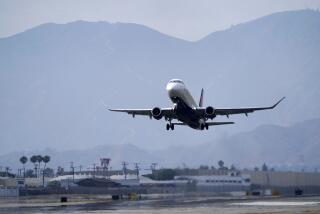Crew Failed to Fix Faulty Rudder Setting Before East River Jet Crash, Data Shows
- Share via
WASHINGTON — The cockpit crew of USAir’s Flight 5050 called out all the required flight checks but did not fix a misaligned rudder before attempting to take off, according to cockpit transcripts and flight recorder data released Monday.
The plane almost immediately began to drift, causing an aborted takeoff and subsequent skid into New York’s East River Sept. 20.
“All the appropriate items on the before-engine start, after-engine start, the taxi and the before-takeoff checklists were verbalized,” said National Transportation Safety Board Electronics Engineer James R. Cash, who analyzed the flight recorder’s data.
Preliminary reports suggest that the crash, which killed two of the 61 people who boarded the aircraft at La Guardia International Airport, may have been caused by a misaligned stabilizer or rudder, which was checked during the preflight evaluation.
The recording indicated that after the pilots tested the stabilizer, it returned to 15.9 degrees left position when it should have been set for zero. Investigators acknowledged earlier that the misaligned stabilizer could account for the drift and subsequent aborted takeoff.
But National Transportation Safety Board spokesman Ted Lopatkiewicz said the stabilizer is one of many factors that investigators are examining.
“We’re many months away from determining the cause,” he said.
The transcripts, which include the equipment check by the pilots, do not show conclusively whether the crash was caused by human or mechanical error, and further analysis of the flight data is scheduled, investigators said.
The Federal Aviation Administration suspended the licenses of Capt. Michael W. Martin and Co-pilot Constantine Kleissas two days after the crash, when they initially refused to be tested for drug and alcohol use.
Urine samples taken 44 hours after the crash found Martin to have taken a prescription muscle relaxant and an over-the-counter painkiller, which he said he took for injuries he sustained in the crash.
Flight 5050, en route to Charlotte, N.C., marked the first time Kleissas piloted a 737 after completion of flight training. He had flown 3,300 flight hours, mostly in smaller passenger planes.
The transcript illustrates Kleissas’ inexperience. At one point Kleissas accidentally hit a button that disconnected automatic throttle advances, and Martin corrected the mistake manually.
“OK, that’s the wrong button pushed,” Martin told Kleissas seconds into the flight.
“Oh yeah, I knew that,” Kleissas responded.
“It’s the one underneath there,” said Martin. “All right I’ll set your power.”
Five seconds later the transcript indicates “the sound of a bang . . . sound of loud rumble (and) sound similar to throttles hitting the idle stops.”
“Let’s take it back,” Martin said as the rumbling sound increased.
“We’re going off, we’re going off, we’re going off,” Kleissas radioed 20 seconds later, moments before the aircraft skidded into the river.
More to Read
Inside the business of entertainment
The Wide Shot brings you news, analysis and insights on everything from streaming wars to production — and what it all means for the future.
You may occasionally receive promotional content from the Los Angeles Times.










